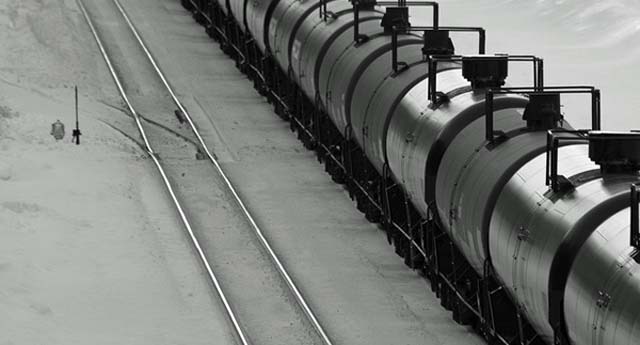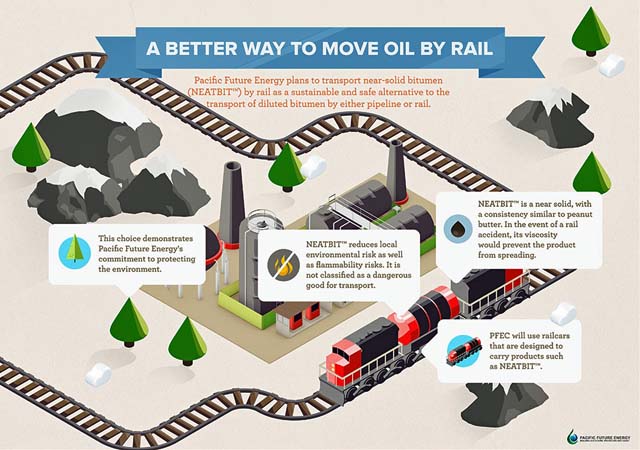

by Rail for Oil Sands Bitumen?
Edmonton Alberta - Albertans are mad in news stories and op-eds, they're mad in the Legislature, and boy, are they ever mad on social
media.
Many believe they traded a carbon tax for pipelines.
So, Premier Notley, where are the pipelines, they ask?
You hear it in the hockey rinks of Edmonton, the downtown eateries of Calgary, and in the bars and cafes of rural towns.
Albertans understand that the continued growth of the oil sands, and the continued growth of the provincial economy, depends upon gaining better access to
markets for oil sands crude.
But what if there was a better, or at least complementary, way to get Alberta oil to market, one that didn't require exhaustive environmental reviews, and was
cost-competitive with pipelines?

Wouldn't governments want to pursue it?
Randy Meyer regularly asks himself that very question.
He's the vice-president of business development and logistics for Altex Energy, a Calgary-based company that ships undiluted bitumen, or "neatbit,"
by rail from Saskatchewan to American refineries.
Meyer says that the 20,000 barrels of Alberta bitumen that currently wend their way to Midwestern refiners every day could become a flood if governments and
industry embrace neatbit.
Neatbit, according to Meyer, has four significant advantages over diluted bitumen, or "dilbit," which contains 30 percent diluent and is usually
shipped in pipelines.
One, diluent often costs more than the oil itself.
Furthermore, oil sands producers buy condensate at a premium to its value when it arrives at U.S. refineries, which are configured to refine heavy
oil.
Extracting diluent at Albertan rail terminals would allow oil sands operators to recycle it, keeping its market value and not paying to transport it to the
U.S. where it sells at a discount.
Two, neatbit-by-rail does not require lengthy, costly, environmental reviews.
The product is already covered by existing railway hazardous materials regulations.
There is some pressure from American environmental groups to more strictly regulate or ban oil-by-rail in general, but for now neatbit gets a free
ride.
Three, it's worth mentioning too, that in the event of a derailment, neatbit is safe.
It has a very low flash point, and there's no diluent to form a volatile layer of vapor above it in the tank, so it doesn't easily catch on fire.
And if a tank car ruptures, neatbit congeals into a blob instead of running into rivers or farmers' fields as dilbit has in the past.
Four, North America has a well-developed rail infrastructure, which already has excess capacity due to the recent and rapid decline of the coal
industry.
Overall, the industry is warming to neatbit.
In April 2016, Cenovus Energy repeated its interest in shipping undiluted bitumen by rail, which was first floated in 2013.
At that time, the Calgary company said it was purchasing some of the specially heated and insulated tanker cars needed to keep the bitumen soft during
transit.
CEO Brian Ferguson told reporters that removing the high-priced condensate from diluted bitumen could improve margins by as much as $2 to $4 a
barrel.
"This would allow us to tiptoe into the midstream part of the business," he said.
"Anything we can do along the value chain to change or improve the product, or change or improve the market, is a good thing."
Kevin Birn of IHS's energy team wrote a 2014 report called "Crude By Rail: The New Logistics of Tight Oil and Oil Sands Growth."
In it, he explains why Cenovus, and other Alberta producers like MEG Energy, are interested in neatbit.
Oil-by-rail is here to stay, he writes.
"The ability of railroads to connect producers with remote refineries, or to go more readily where pipelines may be challenged to reach, will make rail a
permanent feature of delivering inland crude (heavy and light) to refiners in North America."
So how does neatbit-by-rail compare in cost to dilbit-by-pipeline?
As a rule, if both means of transport are carrying the same product, then pipelines are cheaper by about $8 a barrel.
But the cost of diluent, or the "diluent penalty", changes the calculation.
IHS estimates the average transport cost for dilbit by pipeline at $16 per barrel, as opposed to $20.25 for neatbit-by-rail.
Birn says that in a high pipeline cost-to-low rail cost scenario, neatbit is competitive.
But Meyer points out that since the publication of the IHS study in 2014, rail fuel and freight costs have dropped significantly, making neatbit even more
competitive, about 16 percent less than pipelines, by his calculation.
The IHS report argues that, at the very least, rail's "ability to move raw bitumen from Canada's oil sands is cost advantaged over moving bitumen
blends."
And building pipelines to move Alberta crude is a political minefield.
With global oil prices forecast to reach $60 to $70 per barrel in 2017, and a gradual recovery now in sight, time would appear to be of the essence for the
Canadian industry.
The Canadian Association of Petroleum Producers (CAPP) forecast last year that Canadian crude oil production will rise from 3.8 million to 4.9 million b/d, or
5.5 million b/d if diluent is included, by 2030.
"Canada's energy future relies on our ability to get Canadian oil and gas to the people who need it," says CAPP CEO Tim McMillan.
"Connecting Canadian supply to new and growing markets abroad, safely and competitively, is a top priority."
Why, then, are oil sands producers only starting to come around to neatbit-by-rail?
Not surprisingly, just as neatbit has its upsides, it also has some downsides, according to IHS.
For instance, it travels via pipelines to rail terminals as dilbit, and Alberta and Saskatchewan currently lack the necessary infrastructure to handle it, such
as diluent recovery units and neatbit loading facilities, though Meyer says some Altex customers are already tweaking their production equipment to reduce or
eliminate diluent altogether.
Cenovus is already considering the construction of a diluent recovery unit at its Bruderheim crude-by-rail terminal near Edmonton.
Meyer adds that Altex's modern high-throughput loading facility in Lashburn, Saskatchewan, has already demonstrated that costs can be lowered significantly
enough through efficiencies.
But refiners would have to invest in receiving infrastructure to handle neatbit, which needs to be heated to keep it flowing.
The U.S. Gulf Coast has many refineries equipped to handle heavy oil, regional input capacity is about 1.8 million b/d, but it's unclear just how many could
potentially handle raw neatbit.
One refinery that would be equipped to handle neatbit is the $15 billion Pacific Future Energy project, planned for a site near Terrace on the British Columbia
coast.
In June 2016 it filed with federal and provincial regulators a formal project description that could kick off a two-year review process.
The 216,000-b/d facility is billed by promoters as the "world's greenest bitumen-to-fuels refinery," with near net-zero carbon
emissions.
Steam-heated and insulated rail cars operating at 80 degrees Celsius would transport Alberta neatbit the 1,000 kilometers over the Rockies to an unloading
facility specifically designed for raw bitumen.
Jacques Benoit, chief operating officer of Pacific Future Energy, is a big fan of neatbit because of the safety factor, which is critical in the superheated
political atmosphere of B.C.
"Neatbit is much safer than moving gasoline, for instance. If there were to be an accident, if there was a crack in the railcar, the neatbit would fill
that crack and prevent product from coming out," he says.
"As soon as the neatbit hits the air at 20C it becomes a near-solid again. Compare it to lava coming out of a volcano, as soon as the lava hits the air it
solidifies. That's similar to this product."
For his part, Kevin Birn at IHS says neatbit could very well be the answer the industry is looking for, but it's by no means the only contender.
"What you're looking at is a proliferation of a lot of different options for moving crude out of Western Canada, a lot of creativity, but there's no
silver bullet," says Birn.
"I expect to see a lot of niche opportunities and neatbit would be one of them."
But if that is the case, then why aren't the Alberta and Canadian governments backing neatbit-by-rail, even if only as a short-term bridge to pipelines, or as
a complementary option as oil sands production grows?
Terry Hubbard is an assistant deputy minister with Natural Resources Canada.
His department is aware of the neatbit-by-rail option, but has not studied the economics in detail.
Ottawa is still operating under the assumption that pipelines are the most cost-effective and preferred way to get oil to market.
Furthermore, even though significant new infrastructure funding was announced by the Trudeau government, the feds don't pick projects.
"These are typically projects that are advanced either by the private sector or by different levels of government," Hubbard says.
To date, the Alberta government has not advanced a neatbit project nor does it intend to.
"The Government of Alberta does not have plans to discuss neatbit-by-rail with the federal government," says Alberta Energy spokesperson Brad
Hartle.
"Our focus in discussions with the federal government is making sure the pipeline approval process proceeds without undue delay."
The Alberta Petroleum Marketing Commission, which reports to Alberta Energy, seeks out commercial opportunities to increase crude oil market access and,
according to Hartle, has done an analysis of the economic feasibility of neatbit, which it won't share because the report contains "commercially sensitive
information," he says.
The commission has also met with "several proponents of the concept," including Randy Meyer, over the past few years to "understand the
opportunities," according to the Altex executive.
But that's apparently as far as the Alberta NDP government is prepared to go on neatbit.
In November 2015, when Premier Rachel Notley announced Alberta's new climate change strategy, there was a lot of talk about innovation and new technologies
being part of the big picture solution to carbon dioxide emission reduction.
Unfortunately rail transport is more carbon intensive than pipelines.
However, it would get crude to tidewater faster, as it doesn't need politically charged permits.
Randy Meyer and Altex say they can ship bitumen to market safely and cost-effectively in relatively large volumes, if not immediately, then in the near
future.
IHS, a reputable global energy consulting firm, has confirmed opportunities exist for neatbit in some American markets, and that under certain conditions
neatbit is competitive with pipelines.
The Canadian government has made infrastructure money available and could entertain a proposal for neatbit by rail infrastructure from a provincial government
or a private company.
Both the governments of Canada and Alberta say they are committed to improving market access for oil sands crude.
The question remains whether they and the industry will connect the dots on neatbit before Canada loses another opportunity to tap foreign markets because of
an abundance of caution.
Markham Hislop.
of the Canadian Copyright Modernization Act.


